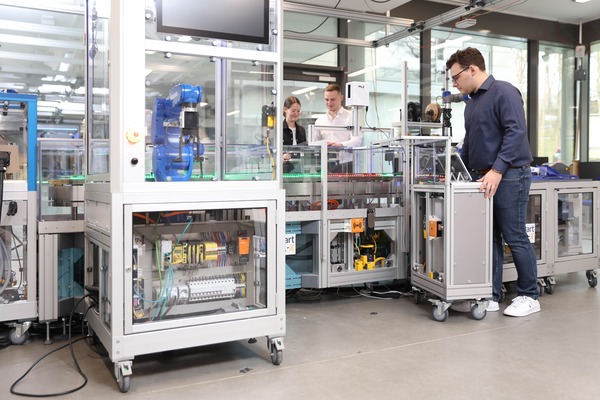Trustworthy AI provides for greater safety and productivity
- What is approaching, a human or a machine?
- Hazardous materials in production and still at full throttle?
- Safety & Security demo at Hannover Messe 2024
Warning signals. Safety cages. Production stops. That is so yesterday. The so-called “yellow safety” measures do reliably protect people from equipment, but sometimes they can slow down productivity. AI is able to keep production speeds as high as possible with no need to sacrifice safety. SmartFactory-KL (SF-KL) takes a holistic approach, analyzing all machine data to detect any deviations (trustworthiness) while focusing on hazardous goods that can slow down work processes. The aim is to provide greater safety by combining safety and security!
Hazardous goods production
At the _KUBA production island, countless workpiece carriers zoom past with model truck components. Controlled by AI, they take the optimal route from production step to production step. Only one workpiece carrier moves noticeably slower and is being carefully avoided. It is carrying batteries, a hazardous material that must be transported with care. “We are showing that we can maintain a high production speed,” said Dr. Detlev Richter from TÜV SÜD, a co-exhibitor at the SF-KL booth at Hannover Messe (HM). “You can see how AI also contributes to safety.” Every workpiece carrier is analyzed at the quality control module. If any anomalies are detected on a battery carrier, the defective battery is immediately ejected from the production process and a certified worker is notified to accept it.
AI as an additional software layer
In addition to quality control, the cybersecurity software monitors the entire plant looking for any anomalies. “That could be the sudden appearance of an unregistered maintenance laptop, or an increase in data traffic, or an illogical value. The overall generic term here is trustworthiness,” said Jamie Wilkie from Fujitsu, another co-exhibitor at HM. Wilkie went on to explain how AI operations are implemented as a supplemental layer to the so-called “yellow safety” precautions. Dynamic safety and security are combined in an “Operational Safety Intelligence Layer.” Safety & Security are designed and implemented with contextual understanding.
What is that movement, a human or a machine?
The _KUBA production island has a modular design that is easily reconfigured. “The release after each new configuration was solved already back in 2020,” said Richter. “Now we need a flexible safety-concept.” Bernd Neuschwander helps to develop a use case at PILZ, a system that reacts flexibly based on the direction of movement and speed of objects in the danger zone. PILZ is also represented at the SF-KL booth. A radar sensor and a laser scanner analyze the direction and speed of every movement in the zone and trigger the appropriate response. “The innovative feature is that the system distinguishes between humans and machines, enabling a flexible response that ranges from slowing down the transport speed to a complete shutdown,” said Neuschwander, “We demonstrate this live at Hannover Messe with an autonomous robot.”
Tips:
The Safety & Security Use Case is presented several times per day in Hall 8, D18.
A whitepaper that explores the topic in detail is now available at: www.smartfactory.de

